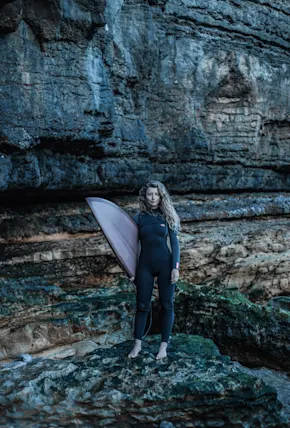No surfer’s quiver is complete without a soft top—or foamie, as the catch-all genre of foam boards are often called. Whether you’re a seasoned surfer or a beginner setting foot in sea for the first time, there’s something about a soft top surfboard that lends itself to creativity, inspiration, and pure stoke.
The wide array of riding styles espoused by soft top enthusiasts has led to an explosion of options on the market, with a growing trend of premium soft tops making the case that foamies are in fact fun for everyone.
To dive into the question of who makes the best soft top surfboard we tapped surf journalist Molly Lockwood, along with a number of other lifelong surfers in the Field Mag fam. So grab your favorite board shorts, swimsuit or bikini, and read on for a proper guide to soft top surfboards, including our top 7 picks for the best foam surfboards for any and skill levels. (Sorry SUP bros, no paddle boards here btw.)
Why Get a Foam Surfboard?
Because foamies are all about fun and catching waves, waves, waves. They’re an invitation to not take yourself so seriously—and a great way to turn small waves into so much more.
On a soft top, you’ve got more buoyancy, improved paddling speed, less risk of damage or injury, and more freedom to go over the falls once in a while. They float like boats and increase your wave-catching power. Less precision, more experimentation. Less paddling, more waves. Less pressure, more fun. Isn’t that what surfing is all about?

Author Molly Lockwood & Momo Otani-Hudes of Benny's Club | Photo by Field Mag
Construction Types: Foamie vs. Soft Top
All foamies are soft tops, but not all soft tops are foamies. Both are typically made from expanded polystyrene (EPS foam), a lighter, more buoyant material than the polyurethane (PU) foam used in most traditional surfboards. Like hard fiberglass surfboards, soft tops often feature a wood stringer at the core for greater structural strength. The outer layer is where the distinctions begin.
Foamies, the gentle, cushiony surfboards evolved from boogie boards, are topped with an additional layer of foam material. As soft top technology has evolved, a new class of hybrid-style boards have emerged that replace the mushy foam deck with a thin layer of high-density polyethylene (HDPE) or epoxy resin. This allows for more advanced design and maneuverability without sacrificing the easygoing, fun-forward characteristics of the soft top.
Which Surfboard Is Right For You?
Foamies are typically favored for beginners thanks to the safety factor, stability, simplicity, and durability, while surfers looking to level up their technique or experiment with new styles will generally prefer the hybrid soft top models.
















